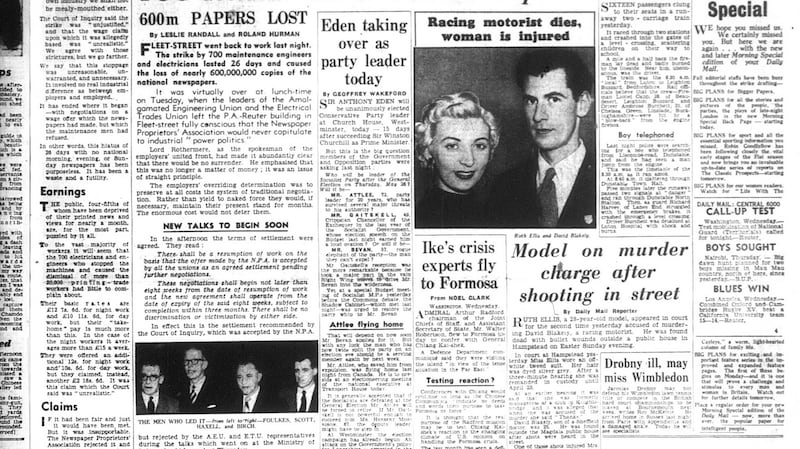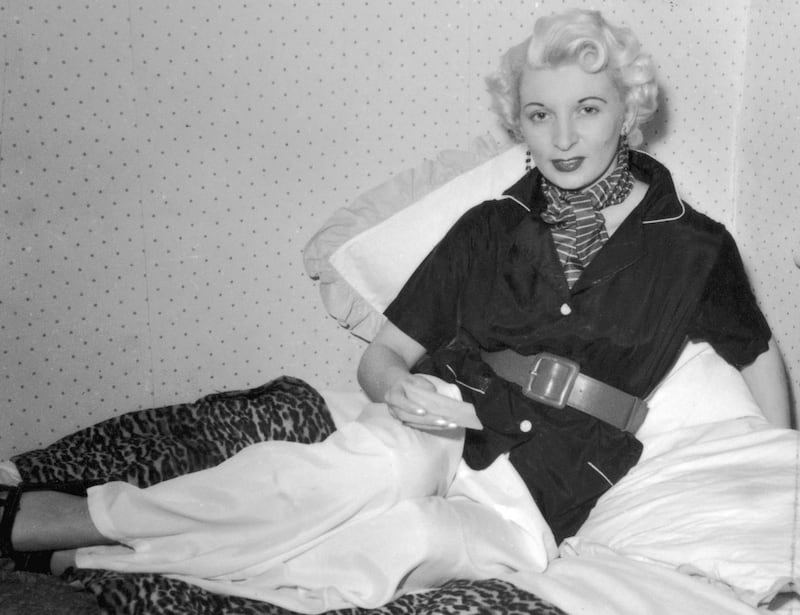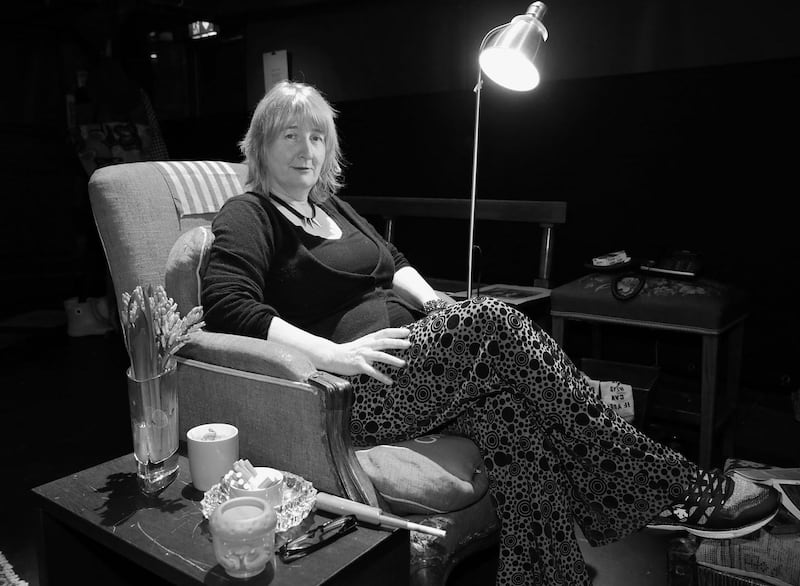There’s much that marks out Ruth Ellis’ execution as a source of fascination, 63 years since it took place in Holloway Prison, London. History books will tell us that it’s because she was the last woman hanged in the UK; perhaps expedited because of the profile of this case, the death penalty was abolished 10 years later.
True crime enthusiasts will say it was the unremorseful nature of the murder, and buried evidence about a co-conspirer that could never be confirmed after her execution. The media certainly helped Ruth Ellis make her mark: she was an ex-nude model who'd dabbled in acting, and her act of passion was against the lover who scorned her, David Blakely, a wealthy socialite and race-car driver.
They met through mutual friends at the Little Club in Mayfair, a notorious anything-goes place where The Krays visited, and where Ellis was a hostess and manager. Together, they shared an alcohol-fuelled passionate and violent relationship until Blakely wanted out, prompting Ellis to seek out his hiding place in Hampstead on Easter Sunday of 1955. Finding him in the Magdala pub, she waited for him to leave, then shot him twice in the back at point blank range. As he lay bleeding on the ground, she continued shooting, then calmly gave up her gun to an off-duty policeman.
“Will you call the police?” she asked him.
“I am the police,” he replied.
“Will you please arrest me?”
Refusing any option to reduce her sentence – like pleading insanity or highlighting the role of her new lover Desmond Cussen, whom had given her the gun and driven her to the pub – her hearing lasted two days, and it took the jury 25 minutes to decide she was guilty. She was hanged on 13 July 1955, aged 28.

She left behind two children, then aged three and 10, and a myriad of questions about her final days, especially surrounding the rushed judicial process, their abusive relationship (which she believed caused her to miscarry), and the role of Cussen in influencing her decision. It left enough doubt that in 2002, her sister appealed her case, albeit unsuccessfully.
"I'd absolutely entertain the conspiracy theory, but there's just some blatant facts," says Christina Reihill, a Dublin-based creative who is interpreting Ruth Ellis's last days as the basis of a new exhibition, Glad I Did It.
“The truth is, Ruth was found with a gun in her hand. She said she shot him. From the minute she was arrested and right through to the day she was being hanged, she was satisfied she had done what she intended to do. At every point, she was encouraged to seek mercy but no, she told her solicitor that she knew what she did and shed die for it.
“People cannot stand the fact that a person, particularly a woman, stands up and says ‘I shot him’. People are scared to admit that that’s in our psyche, that the satisfaction in those acts of revenge, are human. She declared what we all do in subtle levels.”
A central theme to the installation is the universal elements of Ellis’s motive and actions, as extreme as they were.
Dublin-based Reihill, who studied psychology and English at Harvard University, is well-versed in exploring the darker parts of the female psyche. Last year she produced Wit's End at Smock Alley Theatre Dublin, which focused on poet Dorothy Parker's final days before her death.
"Almost on the night of Wit's End's opening when I was ready to collapse, Ruth Ellis came into my head," says Reihill. "I felt she put a gun to my head and said 'me next'. I'd not had that before, where it was so clear and loud in my head.
“Ruth had a physically violent history whereas Dorothy Parker had an intellectually violent history. With both these installations, I know it’s dark material I’m dealing with, and I need to mind myself with it.”
Reihill’s research on Ellis began in the 1980s, when working in London as a journalist with Vogue and the Evening Standard among others, she began researching a book on the infamous Little Club. While the book didn’t come to fruition, Ruth Ellis stayed with her.

“Who would want to stand up and willingly be condemned to death. It’s extremely difficult for us to comprehend,” remarks Reilhill. “And it’s deeper than that. She’s a woman who’s dared to express that level of darkness to the end. She stood in front of Albert [Pierrepoint, her executioner] and grinned at him. He wrote about this until he died; he was haunted by her smile. He said he hanged 430 people, 15 of which were women, and she matched the bravest that stood in front of him.
“I believe she felt a lot of fear. There were moments where she cried in the cell, like when she saw David’s autopsy photographs and when [an MP] was trying to make her stay alive for her children. But she could have only sustained that false pride of not letting anyone see her scared of dying’ for so long, and she was three weeks in cell.”
Describing herself as “a poet, but one that takes words and languages into three dimensional spaces”, Reihill uses Ruth Ellis’s story to hold a mirror to us all. The Bermondsey Project Space, in a warehouse-filled, artsy part of London, is divided into three floors.
“The ground floor has a window on to the street, and that’s where you’ll find Ruth Ellis’s hanging space and a trap door,” Reihill explains. “But everything is symbolic for me. So that’s our own hanging space. How do we hang each ourselves in the choices we make? How do we hang each other? And to passers-by, that’s the window to our soul.

The basement, decorated with fiery red felt walls, has a video interview, in which the artist replies to questions “in a way that I hope invites people to pause and reflect on the answers”.
The focus of the installation is the recreated cell, made up of letters, notes and furniture that evoke the cell in which she lived, knowing exactly when her time would come.
“There’s a seanchaí chair – a chair for storytellers – from the 1800s, because Ruth wanted to be famous, and this is her moment. We all want a seanchai chair and to tell our story. There are pillars in the gallery and I’m using them to evoke the institutional. David wrote her a note of ‘Darling I love you’, and that’s there by her desk; it’s a photograph of the original. And on the desk, there’s copy of her diary. Every day she was in the cell, the doctors and officers kept a note of how she was doing, things like if she was reading, sleeping well or chatting. The diary will be there for people to read and decide for themselves how she was during their time.
“To me, the condemned cell is her mind – it’s our mind. It’s a confined space, but her perception was that it was not. I’m not saying she liked it, but she appreciated her time there, because her she had her dignity. She was called Mrs Ellis. Her opinion was sought and listened to. She never had that in her life.”
It’s no coincidence that there are parallels to be made with a confined cell that turns out to be a reprieve, and Reihill’s own sobriety. After living the high life of a London media type, she moved back to Dublin, sought the help she needed, and has been off drugs and alcohol for 24 years now.
“London threw me out for bad behaviour and I’m coming back with the exhibition as a present, for it to forgive me,” she says. “I tried but I failed to get sober in London. As a city it’s so exciting but it’s fast and it’s hard. Even now if I stay more than three days I’m looking for a bottle of vodka and a lot of cocaine.”
These days, Reihill enjoys a creative life in Monkstown, Dublin, where she lives with her two cats. Her output varies from feature writing to poetry to interactive installations, which are touched by the experiences that have shaped her perception.
“With all of my work, it’s daunting to step in, but I’ve done my job if you want to stay,” she says. “Because that’s what I experienced.”
Christina Reihill’s installation, Glad I Did It, will run from November 14th to December 1st at Bermondsey Project Space, London





















